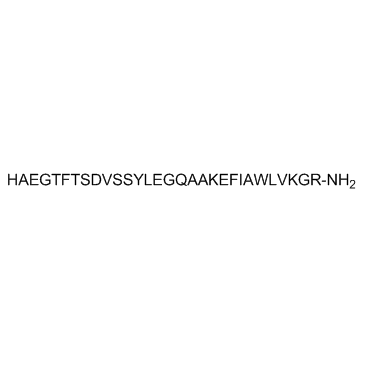Effects of various N-terminal fragments of glucagon-like peptide-1(7-36) on food intake in the neonatal chick.
M Furuse, T Bungo, M Shimojo, Y Masuda, N Saito, S Hasegawa, K Sugahara
Index: Brain Res. 807(1-2) , 214-7, (1998)
Full Text: HTML
Abstract
Recently, the suppressive effect on food intake by the central administration of glucagon-like peptide-1 (GLP-1) has been confirmed in both rats and chicks. The importance of the N-terminal amino acid, histidine, for the bioactivity of GLP-1(7-36) in the central nervous system was suggested, though the role for C-terminal amino acids in the central nervous system has not been reported. The present study was done to elucidate the central effect of N-terminal fragments of GLP-1(7-36) on food intake of the neonatal chick. Intracerebroventricular (i.c.v.) administration of mammalian GLP-1(7-36) inhibited food intake of chicks, but the fragments of GLP-1(7-16) and GLP-1(7-26) did not show the suppressive effect on food intake. Furthermore, the extended fragments, GLP-1(7-30) and GLP-1(7-33), also had no effects on food intake. It is concluded that C-terminal amino acids of GLP-1(7-36) have an important role for the bioactivity in the central nervous system with special reference to feeding behavior.Copyright 1998 Elsevier Science B.V.
Related Compounds
| Structure | Name/CAS No. | Molecular Formula | Articles |
|---|---|---|---|
 |
GLP-1 (7-36) amide (human, bovine, guinea pig, mouse, rat) trifluoroacetate salt
CAS:107444-51-9 |
C149H226N40O45 |
|
Lys9 for Glu9 substitution in glucagon-like peptide-1(7-36)a...
2004-02-01 [Metab. Clin. Exp. 53(2) , 252-9, (2004)] |
|
Coexpression of glucagon-like peptide-1 (GLP-1) receptor, va...
1999-01-01 [J. Neurochem. 72(1) , 10-6, (1999)] |
|
Elevated post-prandial gastric inhibitory polypeptide concen...
1997-10-01 [Clin. Sci. 93(4) , 343-7, (1997)] |
|
Simultaneous determination of incretin hormones and their tr...
2004-04-15 [J. Chromatogr. B. Analyt. Technol. Biomed. Life Sci. 803(1) , 91-9, (2004)] |
|
Intracerebroventricular glucagon-like peptide-1 (7-36) amide...
1998-06-01 [Physiol. Behav. 64(3) , 367-72, (1998)] |